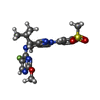[English] 日本語
 Yorodumi
Yorodumi- PDB-5kyj: Brain penetrant liver X receptor (LXR) modulators based on a 2,4,... -
+ Open data
Open data
- Basic information
Basic information
| Entry | Database: PDB / ID: 5kyj | ||||||
|---|---|---|---|---|---|---|---|
| Title | Brain penetrant liver X receptor (LXR) modulators based on a 2,4,5,6-tetrahydropyrrolo[3,4-c]pyrazole core | ||||||
 Components Components |
| ||||||
 Keywords Keywords | DNA BINDING PROTEIN / Nuclear receptors / Liver X Receptor / Retinoic Acid X Receptor / LXRbeta-LBD/RXRbeta-LBD heterodimer / Chemical modulators | ||||||
| Function / homology |  Function and homology information Function and homology informationpositive regulation of secretion of lysosomal enzymes / positive regulation of high-density lipoprotein particle assembly / positive regulation of pancreatic juice secretion / phosphatidylcholine acyl-chain remodeling / negative regulation of response to endoplasmic reticulum stress / ventricular cardiac muscle cell differentiation / negative regulation of pinocytosis / maternal placenta development / regulation of lipid storage / positive regulation of triglyceride biosynthetic process ...positive regulation of secretion of lysosomal enzymes / positive regulation of high-density lipoprotein particle assembly / positive regulation of pancreatic juice secretion / phosphatidylcholine acyl-chain remodeling / negative regulation of response to endoplasmic reticulum stress / ventricular cardiac muscle cell differentiation / negative regulation of pinocytosis / maternal placenta development / regulation of lipid storage / positive regulation of triglyceride biosynthetic process / apolipoprotein A-I receptor binding / retinoic acid-responsive element binding / NR1H2 & NR1H3 regulate gene expression linked to triglyceride lipolysis in adipose / NR1H2 & NR1H3 regulate gene expression linked to gluconeogenesis / NR1H2 & NR1H3 regulate gene expression to limit cholesterol uptake / NR1H2 & NR1H3 regulate gene expression linked to lipogenesis / positive regulation of lipid storage / positive regulation of fatty acid biosynthetic process / negative regulation of lipid transport / positive regulation of vitamin D receptor signaling pathway / negative regulation of cold-induced thermogenesis / positive regulation of cholesterol transport / Signaling by Retinoic Acid / NR1H2 & NR1H3 regulate gene expression to control bile acid homeostasis / negative regulation of type II interferon-mediated signaling pathway / negative regulation of cholesterol storage / nuclear steroid receptor activity / negative regulation of macrophage derived foam cell differentiation / positive regulation of cholesterol efflux / cardiac muscle cell proliferation / positive regulation of bone mineralization / nuclear retinoid X receptor binding / retinoic acid receptor signaling pathway / NR1H3 & NR1H2 regulate gene expression linked to cholesterol transport and efflux / intracellular receptor signaling pathway / hormone-mediated signaling pathway / cellular response to retinoic acid / negative regulation of proteolysis / cholesterol homeostasis / VLDLR internalisation and degradation / RNA polymerase II transcription regulatory region sequence-specific DNA binding / SUMOylation of intracellular receptors / response to nutrient levels / mRNA transcription by RNA polymerase II / PPARA activates gene expression / chromatin DNA binding / Nuclear Receptor transcription pathway / positive regulation of miRNA transcription / negative regulation of inflammatory response / RNA polymerase II transcription regulator complex / nuclear receptor activity / sequence-specific double-stranded DNA binding / nervous system development / ATPase binding / DNA-binding transcription activator activity, RNA polymerase II-specific / in utero embryonic development / DNA-binding transcription factor activity, RNA polymerase II-specific / cell differentiation / RNA polymerase II cis-regulatory region sequence-specific DNA binding / negative regulation of gene expression / negative regulation of DNA-templated transcription / positive regulation of gene expression / chromatin / positive regulation of DNA-templated transcription / nucleolus / negative regulation of transcription by RNA polymerase II / positive regulation of transcription by RNA polymerase II / DNA binding / zinc ion binding / nucleoplasm / nucleus / cytosol / cytoplasm Similarity search - Function | ||||||
| Biological species |  Homo sapiens (human) Homo sapiens (human) | ||||||
| Method |  X-RAY DIFFRACTION / X-RAY DIFFRACTION /  SYNCHROTRON / SYNCHROTRON /  MOLECULAR REPLACEMENT / Resolution: 2.8 Å MOLECULAR REPLACEMENT / Resolution: 2.8 Å | ||||||
 Authors Authors | Chen, G. / McKeever, B.M. | ||||||
 Citation Citation |  Journal: Bioorg.Med.Chem.Lett. / Year: 2016 Journal: Bioorg.Med.Chem.Lett. / Year: 2016Title: Brain penetrant liver X receptor (LXR) modulators based on a 2,4,5,6-tetrahydropyrrolo[3,4-c]pyrazole core. Authors: Tice, C.M. / Noto, P.B. / Fan, K.Y. / Zhao, W. / Lotesta, S.D. / Dong, C. / Marcus, A.P. / Zheng, Y.J. / Chen, G. / Wu, Z. / Van Orden, R. / Zhou, J. / Bukhtiyarov, Y. / Zhao, Y. / Lipinski, ...Authors: Tice, C.M. / Noto, P.B. / Fan, K.Y. / Zhao, W. / Lotesta, S.D. / Dong, C. / Marcus, A.P. / Zheng, Y.J. / Chen, G. / Wu, Z. / Van Orden, R. / Zhou, J. / Bukhtiyarov, Y. / Zhao, Y. / Lipinski, K. / Howard, L. / Guo, J. / Kandpal, G. / Meng, S. / Hardy, A. / Krosky, P. / Gregg, R.E. / Leftheris, K. / McKeever, B.M. / Singh, S.B. / Lala, D. / McGeehan, G.M. / Zhuang, L. / Claremon, D.A. | ||||||
| History |
|
- Structure visualization
Structure visualization
| Structure viewer | Molecule:  Molmil Molmil Jmol/JSmol Jmol/JSmol |
|---|
- Downloads & links
Downloads & links
- Download
Download
| PDBx/mmCIF format |  5kyj.cif.gz 5kyj.cif.gz | 201.6 KB | Display |  PDBx/mmCIF format PDBx/mmCIF format |
|---|---|---|---|---|
| PDB format |  pdb5kyj.ent.gz pdb5kyj.ent.gz | 158.7 KB | Display |  PDB format PDB format |
| PDBx/mmJSON format |  5kyj.json.gz 5kyj.json.gz | Tree view |  PDBx/mmJSON format PDBx/mmJSON format | |
| Others |  Other downloads Other downloads |
-Validation report
| Summary document |  5kyj_validation.pdf.gz 5kyj_validation.pdf.gz | 995.2 KB | Display |  wwPDB validaton report wwPDB validaton report |
|---|---|---|---|---|
| Full document |  5kyj_full_validation.pdf.gz 5kyj_full_validation.pdf.gz | 1006.6 KB | Display | |
| Data in XML |  5kyj_validation.xml.gz 5kyj_validation.xml.gz | 33.8 KB | Display | |
| Data in CIF |  5kyj_validation.cif.gz 5kyj_validation.cif.gz | 45.7 KB | Display | |
| Arichive directory |  https://data.pdbj.org/pub/pdb/validation_reports/ky/5kyj https://data.pdbj.org/pub/pdb/validation_reports/ky/5kyj ftp://data.pdbj.org/pub/pdb/validation_reports/ky/5kyj ftp://data.pdbj.org/pub/pdb/validation_reports/ky/5kyj | HTTPS FTP |
-Related structure data
| Related structure data |  5kyaC  5i4vS S: Starting model for refinement C: citing same article ( |
|---|---|
| Similar structure data |
- Links
Links
- Assembly
Assembly
| Deposited unit | 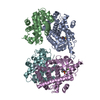
| ||||||||||||||||||||||||||||||||||||||||||||||||||||||||||||||||||||
|---|---|---|---|---|---|---|---|---|---|---|---|---|---|---|---|---|---|---|---|---|---|---|---|---|---|---|---|---|---|---|---|---|---|---|---|---|---|---|---|---|---|---|---|---|---|---|---|---|---|---|---|---|---|---|---|---|---|---|---|---|---|---|---|---|---|---|---|---|---|
| 1 | 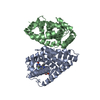
| ||||||||||||||||||||||||||||||||||||||||||||||||||||||||||||||||||||
| 2 | 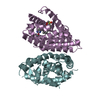
| ||||||||||||||||||||||||||||||||||||||||||||||||||||||||||||||||||||
| Unit cell |
| ||||||||||||||||||||||||||||||||||||||||||||||||||||||||||||||||||||
| Noncrystallographic symmetry (NCS) | NCS domain:
NCS domain segments: Component-ID: _ / Refine code: _
NCS ensembles :
| ||||||||||||||||||||||||||||||||||||||||||||||||||||||||||||||||||||
| Details | Dimer confirmed by size exclusion chromatography |
- Components
Components
| #1: Protein | Mass: 32457.008 Da / Num. of mol.: 2 / Mutation: G213H, E214M, Q259A, R261G, D262S, R264S Source method: isolated from a genetically manipulated source Source: (gene. exp.)  Homo sapiens (human) / Gene: NR1H2, LXRB, NER, UNR / Plasmid: pCOLADuet-1 / Production host: Homo sapiens (human) / Gene: NR1H2, LXRB, NER, UNR / Plasmid: pCOLADuet-1 / Production host:  #2: Protein | Mass: 28252.461 Da / Num. of mol.: 2 / Mutation: G293M Source method: isolated from a genetically manipulated source Source: (gene. exp.)  Homo sapiens (human) / Gene: RXRB, NR2B2 / Plasmid: pCOLADuet-1 / Production host: Homo sapiens (human) / Gene: RXRB, NR2B2 / Plasmid: pCOLADuet-1 / Production host:  #3: Chemical | #4: Water | ChemComp-HOH / | |
|---|
-Experimental details
-Experiment
| Experiment | Method:  X-RAY DIFFRACTION / Number of used crystals: 1 X-RAY DIFFRACTION / Number of used crystals: 1 |
|---|
- Sample preparation
Sample preparation
| Crystal | Density Matthews: 2.12 Å3/Da / Density % sol: 41.98 % / Description: Rods 50 to 100um long |
|---|---|
| Crystal grow | Temperature: 298 K / Method: vapor diffusion, hanging drop / pH: 8 Details: 1uL of scLXRbeta-LBD/scRXRbeta-LBD @ 10 mg protein/ml in 20 mM Tris-HCl pH 8.0, 150 mM NaCl, 5 mM DTT containing 1mM ligand and less than 2%(v/v) DMSO was mixed with 1uL of reservoir ...Details: 1uL of scLXRbeta-LBD/scRXRbeta-LBD @ 10 mg protein/ml in 20 mM Tris-HCl pH 8.0, 150 mM NaCl, 5 mM DTT containing 1mM ligand and less than 2%(v/v) DMSO was mixed with 1uL of reservoir solution (0.2M LiCl, 16-20%(w/v) PEG3350, 7-10%(v/v) ethylene glycol, 0.01M Strontium chloride) on a circular, silanized glass cover slide and inverted and sealed with silicon grease over a well of 200uL of reservoir solution. Crystallization plates were incubated at 23 deg C for 2-5 days before rods would appear measuring 50 to 100um long. PH range: 7.5 - 8.5 |
-Data collection
| Diffraction | Mean temperature: 100 K / Ambient temp details: CryoJet - Nitrogen gas |
|---|---|
| Diffraction source | Source:  SYNCHROTRON / Site: SYNCHROTRON / Site:  NSLS NSLS  / Beamline: X29A / Wavelength: 1.075 Å / Beamline: X29A / Wavelength: 1.075 Å |
| Detector | Type: ADSC QUANTUM 315r / Detector: CCD / Date: Feb 18, 2012 |
| Radiation | Protocol: SINGLE WAVELENGTH / Monochromatic (M) / Laue (L): M / Scattering type: x-ray |
| Radiation wavelength | Wavelength: 1.075 Å / Relative weight: 1 |
| Reflection | Resolution: 2.8→43.81 Å / Num. obs: 24770 / % possible obs: 99.82 % / Observed criterion σ(F): 0 / Observed criterion σ(I): 0 / Redundancy: 7.6 % / Biso Wilson estimate: 56.6 Å2 / Net I/σ(I): 19.4 |
| Reflection shell | Resolution: 2.8→2.872 Å / Redundancy: 7.8 % / Mean I/σ(I) obs: 2.47 / % possible all: 99.57 |
- Processing
Processing
| Software |
| ||||||||||||||||||||||||||||||||||||||||||||||||||||||||||||||||||||||||||||||||||||||||||||||||||||||||||||||||||||||||||||||||||||||||||||||||||||||||||||||||||||||||||||||||||||||
|---|---|---|---|---|---|---|---|---|---|---|---|---|---|---|---|---|---|---|---|---|---|---|---|---|---|---|---|---|---|---|---|---|---|---|---|---|---|---|---|---|---|---|---|---|---|---|---|---|---|---|---|---|---|---|---|---|---|---|---|---|---|---|---|---|---|---|---|---|---|---|---|---|---|---|---|---|---|---|---|---|---|---|---|---|---|---|---|---|---|---|---|---|---|---|---|---|---|---|---|---|---|---|---|---|---|---|---|---|---|---|---|---|---|---|---|---|---|---|---|---|---|---|---|---|---|---|---|---|---|---|---|---|---|---|---|---|---|---|---|---|---|---|---|---|---|---|---|---|---|---|---|---|---|---|---|---|---|---|---|---|---|---|---|---|---|---|---|---|---|---|---|---|---|---|---|---|---|---|---|---|---|---|---|
| Refinement | Method to determine structure:  MOLECULAR REPLACEMENT MOLECULAR REPLACEMENTStarting model: 5I4V Resolution: 2.8→43.81 Å / Cor.coef. Fo:Fc: 0.944 / Cor.coef. Fo:Fc free: 0.903 / SU B: 16.09 / SU ML: 0.312 / Cross valid method: THROUGHOUT / ESU R Free: 0.398 / Details: HYDROGENS HAVE BEEN ADDED IN THE RIDING POSITIONS
| ||||||||||||||||||||||||||||||||||||||||||||||||||||||||||||||||||||||||||||||||||||||||||||||||||||||||||||||||||||||||||||||||||||||||||||||||||||||||||||||||||||||||||||||||||||||
| Solvent computation | Ion probe radii: 0.8 Å / Shrinkage radii: 0.8 Å / VDW probe radii: 1.2 Å | ||||||||||||||||||||||||||||||||||||||||||||||||||||||||||||||||||||||||||||||||||||||||||||||||||||||||||||||||||||||||||||||||||||||||||||||||||||||||||||||||||||||||||||||||||||||
| Displacement parameters | Biso mean: 56.58 Å2
| ||||||||||||||||||||||||||||||||||||||||||||||||||||||||||||||||||||||||||||||||||||||||||||||||||||||||||||||||||||||||||||||||||||||||||||||||||||||||||||||||||||||||||||||||||||||
| Refinement step | Cycle: 1 / Resolution: 2.8→43.81 Å
| ||||||||||||||||||||||||||||||||||||||||||||||||||||||||||||||||||||||||||||||||||||||||||||||||||||||||||||||||||||||||||||||||||||||||||||||||||||||||||||||||||||||||||||||||||||||
| Refine LS restraints |
|
 Movie
Movie Controller
Controller


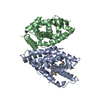
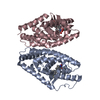

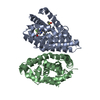
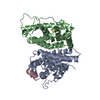
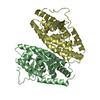
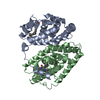
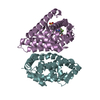

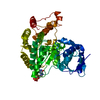
 PDBj
PDBj



